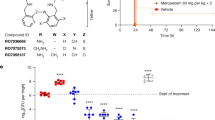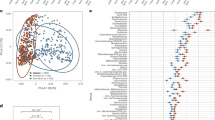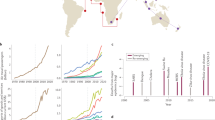Abstract
Bacteria that cause infections in humans can develop or acquire resistance to antibiotics commonly used against them1,2. Antimicrobial resistance (in bacteria and other microbes) causes significant morbidity worldwide, and some estimates indicate the attributable mortality could reach up to 10 million by 20502,3,4. Antibiotic resistance in bacteria is believed to develop largely under the selective pressure of antibiotic use; however, other factors may contribute to population level increases in antibiotic resistance1,2. We explored the role of climate (temperature) and additional factors on the distribution of antibiotic resistance across the United States, and here we show that increasing local temperature as well as population density are associated with increasing antibiotic resistance (percent resistant) in common pathogens. We found that an increase in temperature of 10 °C across regions was associated with an increases in antibiotic resistance of 4.2%, 2.2%, and 2.7% for the common pathogens Escherichia coli, Klebsiella pneumoniae and Staphylococcus aureus. The associations between temperature and antibiotic resistance in this ecological study are consistent across most classes of antibiotics and pathogens and may be strengthening over time. These findings suggest that current forecasts of the burden of antibiotic resistance could be significant underestimates in the face of a growing population and climate change4.
This is a preview of subscription content, access via your institution
Access options
Access Nature and 54 other Nature Portfolio journals
Get Nature+, our best-value online-access subscription
$29.99 / 30 days
cancel any time
Subscribe to this journal
Receive 12 print issues and online access
$209.00 per year
only $17.42 per issue
Buy this article
- Purchase on Springer Link
- Instant access to full article PDF
Prices may be subject to local taxes which are calculated during checkout


Similar content being viewed by others
References
Holmes, A. H. et al. Understanding the mechanisms and drivers of antimicrobial resistance. Lancet 387, 176–187 (2016).
Nathan, C. & Cars, O. Antibiotic resistance—problems, progress, and prospects. N. Engl. J. Med. 371, 1761–1763 (2014).
Global Action Plan on Antimicrobial Resistance (World Health Organization, 2015).
O’Neill, J. Tackling Drug-Resistant Infections Globally: Final Report and Recommendations (HM Government and Wellcome Trust, 2016).
Patz, J. A. et al. in Climate Change and Human Health: Risks and Responses (eds McMichael, A. J. et al.) Ch. 6 (World Health Organization, Geneva, 2003); www.who.int/globalchange/environment/en/chapter6.pdf
Feero, W. G., Guttmacher, A. E. & Relman, D. A. Microbial genomics and infectious diseases. N. Engl. J. Med 365, 347–357 (2011).
Wellington, E. M. H. et al. The role of the natural environment in the emergence of antibiotic resistance in Gram-negative bacteria. Lancet Infect. Dis. 13, 155–165 (2013).
Lorenz, M. G. & Wackernagel, W. Bacterial gene transfer by natural genetic transformation in the environment. Microbiol. Rev. 58, 563–602 (1994).
Walsh, T. R., Weeks, J., Livermore, D. M. & Toleman, M. A. Dissemination of NDM-1 positive bacteria in the New Delhi environment and its implications for human health: an environmental point prevalence study. Lancet Infect. Dis. 11, 355–362 (2011).
MacFadden, D. R. et al. A platform for monitoring regional antimicrobial resistance, using online data sources: ResistanceOpen. J. Infect. Dis. 214, S393–S398 (2016).
Fridken, S. Antibiotic Resistance Patient Safety Atlas (Centers for Disease Control and Prevention, 2016); https://gis.cdc.gov/grasp/PSA/indexAU.html
General Population and Housing Characteristics: 2010 Demographic Profile (US Census Bureau, 2010); https://factfinder.census.gov
Peleg, A. Y. & Hooper, D. C. Hospital-acquired infections due to Gram-negative bacteria. N. Engl. J. Med. 362, 1804–1813 (2010).
Boucher, H. W. et al. Bad bugs, no drugs: no ESKAPE! An update from the Infectious Diseases Society of America. Clin. Infect. Dis. 48, 1–12 (2009).
Arguez, A. et al. NOAA’s 1981–2010 US NOAA’s 1981–2010 U.S. climate normals: an overview. Bull. Am. Meteorol. Soc. 93, 1687–1697 (2012).
Sutherst, R. W. Global change and human vulnerability to vector-borne diseases. Clin. Microbiol. Rev. 17, 136–173 (2004).
Clarke, A. et al. A low temperature limit for life on Earth. PLoS ONE 8, e66207 (2013).
Hicks, L. A., Taylor, T. H. Jr & Hunkler, R. J. US outpatient antibiotic prescribing, 2010. N. Engl. J. Med. 368, 1461–1462 (2013).
Hicks, L. A. et al. US outpatient antibiotic prescribing variation according to geography, patient population, and provider specialty in 2011. Clin. Infect. Dis. 60, 1308–1316 (2015).
Hilty, M. et al. Transmission dynamics of extended-spectrum β-lactamase-producing Enterobacteriaceae in the tertiary care hospital and the household setting. Clin. Infect. Dis. 55, 967–975 (2012).
Warnes, S. L., Highmore, C. J. & Keevil, C. W. Horizontal transfer of antibiotic resistance genes on abiotic touch surfaces: implications for public health. mBio 3, e00489 (2012).
Goossens, H., Ferech, M., van der Stichele, R., Elseviers, M. & ESAC Project Group. Outpatient antibiotic use in Europe and association with resistance: a cross-national database study. Lancet 365, 579–587 (2005).
Poirel, L., Potron, A. & Nordmann, P. OXA-48-like carbapenemases: the phantom menace. J. Antimicrob. Chemother. 67, 1597–1606 (2012).
Liu, Y.-Y. et al. Emergence of plasmid-mediated colistin resistance mechanism MCR-1 in animals and human beings in China: a microbiological and molecular biological study. Lancet Infect. Dis. 16, 161–168 (2016).
Shah, H. N. & Gharbia, S. E. The impact of the environment on human infections. Microb. Ecol. Health Dis. 11, 248–254 (1999).
Ratkowsky, D. A., Olley, J., Mcmeekin, T. A. & Ball, A. A. Relationship between temperature and growth rate of bacterial cultures. J. Bacteriol. 149, 1–5 (1982).
Dipl-Vw, K. K., Frank, U., Conrad, A. & Meyer, E. Seasonal and ascending trends in the incidence of carriage of extended-spectrum β-lactamase-producing Escherichia coli and Klebsiella species in 2 German hospitals. Infect. Control Hosp. Epidemiol. 31, 1154–1159 (2010).
Perencevich, E. N. et al. Summer peaks in the incidences of Gram-negative bacterial infection among hospitalized patients. Infect. Control Hosp. Epidemiol. 29, 1124–1131 (2008).
Mermel, L. A., Machan, J. T., Parenteau, S., Brown, S. M. & Jones, K. Seasonality of MRSA infections. PLoS ONE 6, e17925 (2011).
Gautam, R. et al. Modeling the effect of seasonal variation in ambient temperature on the transmission dynamics of a pathogen with a free-living stage: example of Escherichia coli O157:H7 in a dairy herd. Prev. Vet. Med. 102, 10–21 (2011).
Levin, B. R. Minimizing potential resistance: a population dynamics view. Clin. Infect. Dis. 33, S161–S169 (2001).
IPCC Climate Change 2013: The Physical Science Basis (eds Stocker, T. F. et al.) (Cambridge Univ. Press, 2014).
Bruinsma, N. et al. Influence of population density on antibiotic resistance. J. Antimicrob. Chemother. 51, 385–390 (2003).
Acknowledgements
D.R.M. is supported by a Canadian Institute for Health Research Fellowship Grant and the Clinician Scientist Program at the Department of Medicine, University of Toronto. J.S.B. is supported by the National Library of Medicine NIH R01 LM011965. Thank you to the developers and data analysts at HealthMap for their support. Thank you to M. Kramer for his thoughtful and insightful review and feedback.
Author information
Authors and Affiliations
Contributions
D.R.M., S.F.M. and M.S. contributed to the data analysis. All the authors (D.R.M., S.F.M., D.F., M.S. and J.S.B.) contributed to development of the manuscript, discussion and preparation of final versions. All the authors approved the final version of the manuscript.
Corresponding authors
Ethics declarations
Competing interests
The authors declare no competing interests.
Additional information
Publisher’s note: Springer Nature remains neutral with regard to jurisdictional claims in published maps and institutional affiliations.
Supplementary information
Supplementary Information
Supplementary figures 1–8, Supplementary tables 1–4
Rights and permissions
About this article
Cite this article
MacFadden, D.R., McGough, S.F., Fisman, D. et al. Antibiotic resistance increases with local temperature. Nature Clim Change 8, 510–514 (2018). https://doi.org/10.1038/s41558-018-0161-6
Received:
Accepted:
Published:
Issue Date:
DOI: https://doi.org/10.1038/s41558-018-0161-6
This article is cited by
-
Genetic toolbox for Photorhabdus and Xenorhabdus: pSEVA based heterologous expression systems and CRISPR/Cpf1 based genome editing for rapid natural product profiling
Microbial Cell Factories (2024)
-
Antibiotic resistance is a growing threat — is climate change making it worse?
Nature (2024)
-
Plasmids, a molecular cornerstone of antimicrobial resistance in the One Health era
Nature Reviews Microbiology (2024)
-
Genomic surveillance for antimicrobial resistance — a One Health perspective
Nature Reviews Genetics (2024)
-
Climate change impact on the healthcare provided to patients
Bulletin of the National Research Centre (2023)



